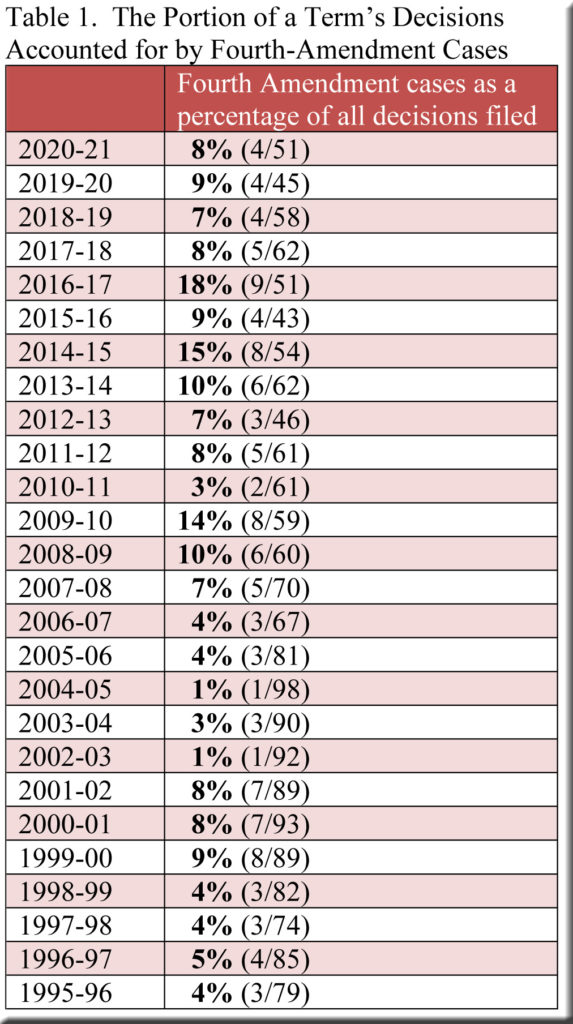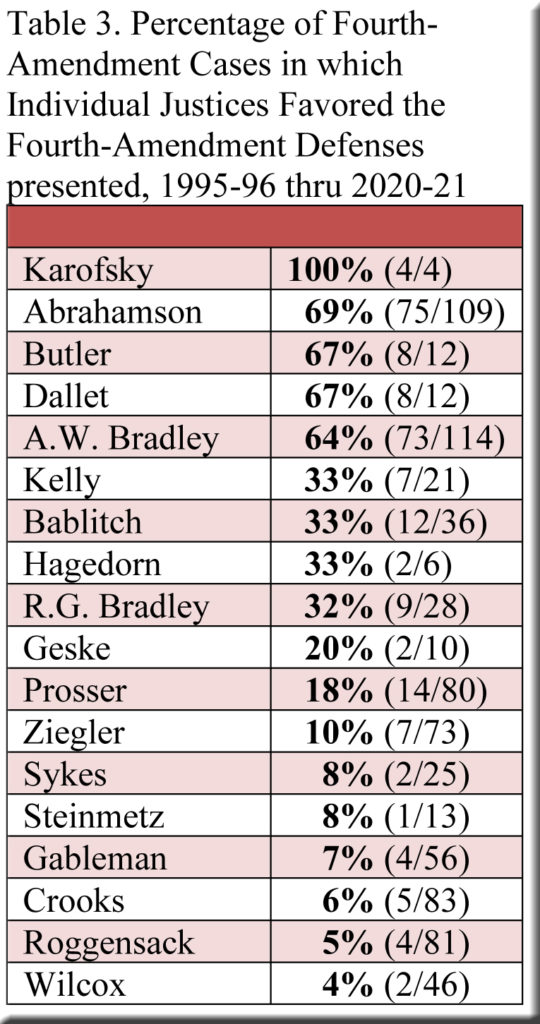With two terms completed since our last update, it’s time for another look at how the justices are handling Fourth-Amendment cases—more specifically, how many of these cases they are accepting; how sympathetically they are reacting to Fourth-Amendment arguments; and how they compare to their predecessors on the bench.
Number of Fourth-Amendment Cases
Surveying the percentage of the court’s docket devoted to Fourth-Amendment cases in each term since 1995-96, earlier posts found that the six highest percentages all bunched late in this interval, between 2008-09 and 2016-17. During these nine terms, Fourth-Amendment cases accounted for 10% of the court’s decisions, with the peak coming in 2016-17 when nine of 51 decisions (18%) addressed Fourth-Amendment arguments. The previous update reported figures slightly below this recent average of 10%, and they remained in this range for 2019-20 (9%) and 2020-21 (8%), as shown in Table 1.[1]
Percentage of Decisions Favorable to Defendants
In 2019-20 and 2020-21, defendants persuaded a majority of the court in 38% of Fourth-Amendment cases. Viewed in isolation, this may not seem like a dramatic success rate, but it dwarfs the percentages for any of the earlier intervals displayed in Table 2, including the “Louis Butler years” (2004-05 through 2007-08)—when the court had a more liberal cast than it acquired after Justice Gableman replaced Justice Butler.[2]
Moreover, the success rate for defendants in Fourth-Amendment cases in 2019-20 and 2020-21 doubled the success rate for defendants in other criminal cases (38% compared to 19%)—continuing a development first evident during the prior two terms.[3] It will be interesting to see if this trend persists, because, if it does, it will reverse the pattern that prevailed for the 21 preceding terms covered in Table 2, when defendants fared better in non-Fourth-Amendment criminal cases.
Votes by Individual Justices
After updating the results from our previous post, we find the court’s current justices arrayed in three clusters. The three liberals (Justices A.W. Bradley, Dallet, and Karofsky) have accepted Fourth-Amendment arguments in approximately two-thirds or more of the cases they’ve heard, while the two most prominent conservatives, Justices Roggensack (5%) and Ziegler (10%) have very rarely done so. Between these groups reside Justices R.G. Bradley and Hagedorn, who have responded favorably to Fourth-Amendment appeals in one third of such cases. Table 3 provides not only this information but also a sense of how these seven justices compare with colleagues who have served since 1995-96.[4]
[1] Although State v. Timothy E. Dobbs (filed July 3, 2020) addressed the relationship between Fourth and Fifth Amendment issues, it was decided on Fifth Amendment grounds. Thus, it is not one of the Fourth-Amendment cases listed in the table for 2019-20.
[2] I have classified the decision in State v. Dawn M. Prado (June 18, 2021) as “favorable,” because the justices ruled that a law allowing blood draws from incapacitated drivers was unconstitutional on Fourth-Amendment grounds. My hesitation arose from the fact that the decision then concluded that law enforcement’s blood draw in Prado’s case had been conducted in “reasonable reliance” on a law that had not yet been deemed unconstitutional.
[3] I have omitted State v. Dennis Brantner (February 25, 2020) from the non-Fourth-Amendment category, because the decision was partly favorable and partly unfavorable to Dobbs.
[4] The table includes a handful of non-criminal Fourth-Amendment cases, such as the “John Doe” batch from 2015 and a tax case in 2017, where conservatives showed more sympathy to Fourth-Amendment arguments. No such cases were decided in 2019-20 and 2020-21. Justice Roland Day is omitted, because the table covers only the last term of his long tenure (1974-96). The data for Justice Karofsky should be viewed cautiously, as they cover only her first term on the court.



Speak Your Mind